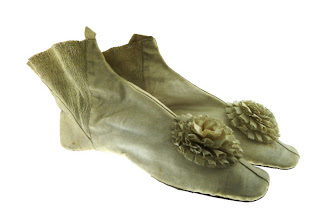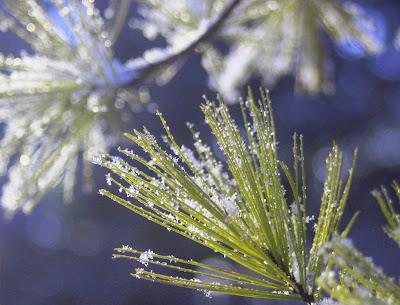Tuesday, February 28, 2012
The Ferries Are Running!
And we were on the first boat off!
My husband was even interviewed by the local news crew, you can see the entire story here.
Monday, February 27, 2012
Paper Roses
"When the flowers of our gardens are faded, their paper substitutes will be welcome again in our houses. The accomplished artist in paper flower making may go direct to Nature for inspiration ; but flowers cannot all be copied even by taking them to pieces. Certain flowers and parts of flowers are copied exactly; others are modified to render their construction practical and simple without being less beautiful. It is only by making a number from good models that sufficient skill and acquaintance with the effects to be produced will enable a lady to go to the garden for her models, just as an artist giving instruction in drawing teaches his pupils the rudiments of his art from paper copies, and does not take them to sketch from Nature till they can fairly represent a landscape on paper, and have mastered the rules of perspective."
Cassell's Household Guide, 1869

Fancy Dress parties were very popular during the mid-nineteenth century. There are dozens of period
accounts of these parties – large and small – where the guests wore costumes and enjoyed an evening of dinner, dancing and entertainment.
Primary sources indicate the depth, breadth and ingenuity of the costumes worn during the period.
Some of the popular costumes were based on:
• Historical characters - Come as a medieval knight, an Elizabethan lady, a Revolutionary War soldier.Historical characters - Come as a medieval knight, an Elizabethan lady, a Revolutionary War soldier.
• Fictional characters – From novels, plays, poetry, art, famous and infamous, e.g. Old Man Winter, Macbeth, the Lady of the Lake.
• Famous personages – Caesar, Cleopatra, Queen Victoria, Henry the Eighth, George Washington, politicians.
• A role or job – A chimney sweep, a cobbler, a basketmaker, a cook, a trapper, a seamstress, a teacher, an inventor or foreign visitor.
• Artifacts – Dress up as an object: a playing card, a barrel, a photograph.
• Allegorical – These can be the most interesting and can make the best use of an existing wardrobe. Themes
can include the four seasons, flowers, jewels, colors, fantasy roles, almost anything.
While the opportunity to relax social norms was part of the appeal of fancy dress, it was also considered somewhat dangerous. For this reason, fancy dress costumes never included masks or face coverings. Masking or masquerades allowed participants too much license and were thought to result in lewd behavior.
I'll be attending a fancy dress party soon and my chosen costume requires literally dozens of flowers, so I started exploring techniques for making paper flowers and actually tried out a couple.
The first was from The Girl's Own Toy-maker, and Book or Recreation circa 1860. The second was Helbronner's Manual of Paper Flower Making, With Complete Patterns and Instructions, circa 1858.
One involved tissue paper cut into scalloped strips, the other tissue paper cut into individual petals that have been crimped:
The tip of a piece of wire is covered in a scrap piece of tissue paper, both to disguise it and to provide a bit of base for the next step:
The strips or petals are next added, carefully pleated into place, so as to emulate an actual rose.
I probably only spent 15 minutes creating a rose using both techniques - and I don't think they look too bad!
Every reference I've found stresses the need to use the more expensive "French tissue paper". After further research, I believe the superiority of French tissue paper is due to it being made of flax, not paper pulp - and of course, not currently available. Sheets of crepe paper are a possible substitution, as it can be goffered and curled.
While I was pleased with my budding ability to make paper roses, I'm in the midst of many projects with tight time lines - so I purchased the roses for my costume.
Making paper flowers uses many of the same techniques as the "La Petite Fleuriste" fabric flowers I discussed previously. Ladies of the period could even purchase precut petals, as well as leaves, stamens, etc. Advertisements stated the availability of packages of supplies to make a large bouquet for $1 - just like Martha Stewart (except for the price!).
I can see myself needing to explore this technique further, some of the flowers described in the Helbronner book are just too interesting, but not right now - one more item on my ever growing "to do" list.
Labels:
botany,
Civil War,
Flowers,
period correct,
period fashion
Saturday, February 25, 2012
Getting Ready To Dance!
We have an opportunity to enjoy some mid-19th century dancing coming up and my dance slippers were in need of some attention - I've danced them literally to pieces!
So I restitched the soles and begged my husband to polish them for me - he does a wonderful job, but it's not a task he enjoys.
I decided it was time to add a bit of period "bling" - rosettes with tiny steel buckles. Godey's and Peterson's both have descriptions and illustrations of shoe rosettes, and I've seen original shoes/dancing slippers with them, after all, your feet will be seen when dancing!
Mine are really quite simple, just a bit of velvet ribbon, looped and tacked in place. It's the buckles which add the real interest; I've written about steel trimming previously, they're fairly readily available but can be pricey - these were purchased as part of a box lot at an auction, another one of my $1 deals.
Here's a few originals, to give you some inspiration:
Not everyone approved of shoe rosettes:
A Bachelor's Protest
June 22, 1861
Chamber's Journal
And why the rosette? Vanity of vanities, it is of no earthly use; it has no more to do with keeping on the shoe, than the ticket inside your hat with keeping that on; it is only another feature of the gigantic scheme. I firmly believe it is symbolical, but fortunately I don't know what a rose may signify in the language of flowers; still I protest against it. Moreover, I protest against stockings, both white and coloured, except black; and I protest against the custom of lifting the dress for the sole purpose of displaying the foot and a few inches of stocking; it can't do the possessor of the foot any good, and it's hard upon a susceptible observer. If the dress is too long, have it shortened, but don't trifle with a man's feelings.
Labels:
Civil War,
dance,
period correct,
rosettes,
shoes
Sunday, February 19, 2012
Bead Journal Project - July 2011
This piece is based on a technique with no name, in fact, a technique I created out of desperation!
In 2004, the Mackinac Island Community Foundation hosted the "Turtles Around Town" - 21 giant fiberglass turtles were embellished be artists, displayed in a variety of locations and auctioned off at a grand celebration.
I was one of the chosen artists and, of course, I wanted to cover my turtle in beads - but there were a few issues I had to figure out how to work around.
1.) The size - did I mention that the turtles were giants? So big that they do not fit in the back of a pickup truck. And we were living in a a very tiny studio apartment, while our house was under construction.
I decided to create typical Island scenes, one for each of the turtles shell plates.
I drew an individual cartoon for each plate:
I then filled in the cartoon with wire and beads - much larger beads then I usually use - my cat supervised the bouncing wire very closely.
I then wired all the individual pieces together and finished with a border. He then went for a ferry ride to St. Ignace to be clear coated.
I used the same technique for this, much smaller piece, my inspiration photo serving as the cartoon. I wanted to keep the background light, so as to highlight the trillium; my background is roughly woven wire.
Not a technique that I'll use very often, but it does have it's applications.
My husband is now the director of the community foundation and they have been considering hosting a similar project - if they do, I will NOT be beading my submission!
Labels:
Bead Journal Project,
beads,
botany,
Mackinac Island,
trillium,
turtle
Wednesday, February 8, 2012
Drift - Bead Journal Project February 2012
My rune stone for February is "Drift".
The idea of drifting is frequently considered to be negative in our society; we are expected to be focused and marching forward toward a goal. "Going with the flow" or allowing ourselves to be carried in directions by outside forces is thought to be a sign of weakness.
But drifting (in moderation) can be positive - we are transformed by our encounters with the random.
I have used a piece of driftwood, collected on the beach, as a cabochon. I've found myself using driftwood in my work frequently - it's quite light weight for it's size. I've even used driftwood as a both sides of a functional clasp. I'm currently working on a very large piece that will include a piece of wood 8 1/2 foot long!
Driftwood frequently shows strong grain lines and I used beads in several shades to show these lines.
My "Drift" runestone is still afloat in beaded water; on the very bottom, the stone can still be viewed.
Once in awhile, allow yourself some drift - be carried by outside forces and see where it takes you!
Labels:
beach,
Bead Journal Project,
beads,
driftwood,
seed beads
Saturday, February 4, 2012
Winter???
Do you like my "snowflake"?
We sure haven't seen many of the real variety - this one is actually a photo of a tree branch that has been altered with a kaleidoscope effect. It's an interesting little program, you just never know what will pop out.
I know we're not the only area of the world experiencing an abnormal winter, but I'm losing patience with our lack of real winter!
This is the greyest winter I've ever experienced on Mackinac, I guess I'm just spoiled - usually we have bright blue, clear days or it's snowing and I enjoy either one of those. But this grey sullenness is just too depressing.
I decided to continue with my 365 Project and it's making it tough to capture much that's interesting, but here's a few I hope you'll enjoy.
Abstract ice in the harbor:
A couple taken on a rare sunny day, enhanced by the dusting of snow that arrived in the night:
I found these HUGE ice crystals one morning; I'm sure it was quite amusing to see me trying take these against a dark background (I'm not much of a contortionist). I really didn't manage to capture the incredible beauty of these:
There is ice out in the Straits; the ferry had to be freed from the ice by the Coast Guard last week and has now stopped until spring. I found this gorgeous blue ice piled up on shore. The pile is over eight feet tall and the individual slabs are about 10" thick:
We can't control the weather obviously, so we just need to make the best of it - the relatively warm weather IS reducing our heating bills after all!
Subscribe to:
Posts (Atom)





































